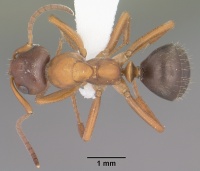Formica wheeleri
| Formica wheeleri | |
|---|---|

| |
| Scientific classification | |
| Kingdom: | Animalia |
| Phylum: | Arthropoda |
| Class: | Insecta |
| Order: | Hymenoptera |
| Family: | Formicidae |
| Subfamily: | Formicinae |
| Tribe: | Formicini |
| Genus: | Formica |
| Species: | F. wheeleri |
| Binomial name | |
| Formica wheeleri Creighton, 1935 | |
This species usually nests under stones, but may construct earthen mounds or even thatched domes in rocky loam soils. Reproductives were found in nests in July, dealate females also in July. The males are apparently very large (Cole, 1955c; Mackay and Mackay 2002).
| At a Glance | • Dulotic |
Identification
The petiole of this species has a blunt apex and is wide as seen from the front. The head is often darker than the mesosoma. The underside of the head usually has a pair of erect hairs. The hairs on the gaster are about 0.1 mm long, and are moderately fine, mostly sharp-tipped. Those on the pronotum are shorter, thicker and at least a few are blunt-tipped. The eyes are large, extending past the sides of the head in most workers. (Mackay and Mackay 2002)
Distribution
United States: Idaho and Montana to North Dakota, south to Nevada, New Mexico and Arizona.
Distribution based on Regional Taxon Lists
Nearctic Region: United States (type locality).
Neotropical Region: Mexico.
Distribution based on AntMaps
Distribution based on AntWeb specimens
Check data from AntWeb
Countries Occupied
| Number of countries occupied by this species based on AntWiki Regional Taxon Lists. In general, fewer countries occupied indicates a narrower range, while more countries indicates a more widespread species. |

|
Estimated Abundance
| Relative abundance based on number of AntMaps records per species (this species within the purple bar). Fewer records (to the left) indicates a less abundant/encountered species while more records (to the right) indicates more abundant/encountered species. |

|
Habitat
In New Mexico (Mackay and Mackay 2002) - Sagebrush scrub, grasslands up to ponderosa pine and aspen-spruce forests.
Biology
This species is a member of a group of Formica species that were formerly placed in the subgenus Raptiformica. All species are facultative slavemakers, i.e., species which usually or often have slaves but can get along without them. The colony-founding female forces her way into a small colony of another species of Formica, somehow gets rid of its queen and workers and appropriates its nest and brood. The workers emerging from this brood accept the intruding queen as their own. The enslaved species belong to the Formica neogagates, fusca, and pallidefulva species groups. When the workers of the slave-making species have become numerous enough, they start raiding for more slaves.
Nevada, Wheeler and Wheeler (1986) We have 2 records from the same locality in the Cool Desert: Washoe Co.: 11 mi. S Reno, 5,500 ft. One nest was under a stone; the other was exposed and surmounted by a low crater of fine soil 37 cm in diameter. The workers were fast and aggressive.
Slave Making
Formica wheeleri is known to enslave the following species:
- Formica altipetens
- Formica bradleyi
- Formica subaenescens
- Formica lasioides
- Formica lepida
- Formica neogagates (Mackay and Mackay, 2002)
- Formica neorufibarbis
Castes
Worker
   
| |
| . | Owned by Museum of Comparative Zoology. |
Images from AntWeb
   
| |
| Cotype of Formica wheeleri. Worker. Specimen code casent0173019. Photographer April Nobile, uploaded by California Academy of Sciences. | Owned by MCZ, Cambridge, MA, USA. |
   
| |
| Worker. Specimen code casent0173021. Photographer April Nobile, uploaded by California Academy of Sciences. | Owned by MCZ, Cambridge, MA, USA. |
  
| |
| Worker. Specimen code casent0173020. Photographer April Nobile, uploaded by California Academy of Sciences. | Owned by MCZ, Cambridge, MA, USA. |
Queen
Images from AntWeb
    
| |
| Queen (alate/dealate). Specimen code casent0173023. Photographer April Nobile, uploaded by California Academy of Sciences. | Owned by MCZ, Cambridge, MA, USA. |
Male
Images from AntWeb
     
| |
| Male (alate). Specimen code casent0173022. Photographer April Nobile, uploaded by California Academy of Sciences. | Owned by MCZ, Cambridge, MA, USA. |
     
| |
| Male (alate). Specimen code casent0173024. Photographer April Nobile, uploaded by California Academy of Sciences. | Owned by MCZ, Cambridge, MA, USA. |
Nomenclature
The following information is derived from Barry Bolton's Online Catalogue of the Ants of the World.
- wheeleri. Formica wheeleri Creighton, 1935: 1, fig. 1 (w.q.) U.S.A. Combination in F. (Raptiformica): Creighton, 1950a: 472.
Description
References
- Creighton, W. S. 1935. Two new species of Formica from western United States. American Museum Novitates 773: 1-8.
- Jansen, G., Savolainen, R. 2010. Molecular phylogeny of the ant tribe Myrmicini (Hymenoptera: Formicidae). Zoological Journal of the Linnean Society 160(3), 482–495 (doi:10.1111/j.1096-3642.2009.00604.x).
- Johnson, C.A. 2000. Mechanisms of dependent colony founding in the slave-making ant, Polyergus breviceps Emery (Hymenoptera: Formicidae). Ph.D. thesis, City University of New York.
- Mackay, W.P. & Mackay, E.E. 2002. The Ants of New Mexico: 400 pp. Edwin Mellen Press, Lewiston, N.Y.
- Wheeler, G. C. and J. Wheeler. 1986. The ants of Nevada. Natural History Museum of Los Angeles County, Los Angeles.
- Wilson, E. O. 1955c. Division of labor in a nest of the slave-making ant Formica wheeleri Creighton. Psyche (Cambridge) 62:130-133. [1955-11-08] 130345.
- Pages using DynamicPageList3 parser function
- Dulotic
- Need species key
- Ant Associate
- Host of Formica altipetens
- Host of Formica bradleyi
- Host of Formica subaenescens
- Host of Formica lasioides
- Host of Formica lepida
- Host of Formica neogagates
- Host of Formica neorufibarbis
- Species
- Extant species
- Formicidae
- Formicinae
- Formicini
- Formica
- Formica wheeleri Creighton
- Formicinae species
- Formicini species
- Formica species
- Need Body Text
- Sanguinea group

